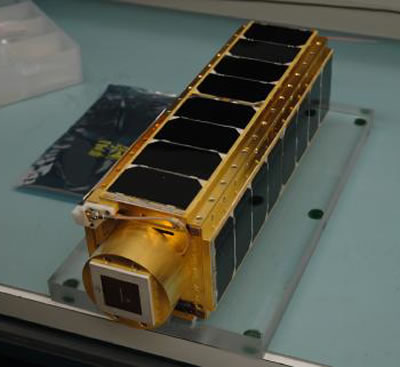Science Fiction
Dictionary
A B C D E F G H I J K L M N O P Q R S T U V W X Y Z
PharmaSat Nano-Satellite Orbiting 'Lab'

PharmaSat and its flight system is an experiment designed to measure the influence of microgravity upon yeast resistance to an antifungal agent. The device is about the size of a loaf of bread; it is a secondary payload on a USAF Minotaur 1 rocket. PharmaSat is completely autonomous, despite its small size - a self-contained orbiting 'lab'.
PharmaSat is intended to accomplish five critical functions in its autonomous free-flyer platform:

(PharmaSat nano-satellite)
The main technology subsystems include a 3-color optical absorbance system, microfluidic networks, multiple reagent delivery system, and miniature environmental control and power management systems.
"PharmaSat is an important experiment that will yield new information about the susceptibility of microbes to antibiotics in the space environment," said David Niesel, PharmaSat's co-investigator at the University of Texas in Galveston."Secondary payload nanosatellites expand the number of opportunities available to conduct research in microgravity by providing an alternative to the International Space Station or space shuttle conducted investigations," said Elwood Agasid, PharmaSat project manager at NASA's Ames Research Center in Moffett Field, Calif.
The PharmaSat project may remind sf readers of Project Scoop, from Michael Crichton's 1969 novel The Andromeda Strain.
In theory, JPL was designing a satellite to enter the fringes of space and collect organisms and dust for study. This was considered a project of pure science...In fact, the true aims were quite different. The true aims of Scoop were to find new life forms that might benefit the Fort Detrick program. In essence, it was a study to discover new biological weapons of war.
From Space.com and PharmaSat at NASA. Thanks to Winchell Chung
Scroll down for more stories in the same category. (Story submitted 5/9/2009)
Follow this kind of news @Technovelgy.| Email | RSS | Blog It | Stumble | del.icio.us | Digg | Reddit |
Would
you like to contribute a story tip?
It's easy:
Get the URL of the story, and the related sf author, and add
it here.
Comment/Join discussion ( 1 )
Related News Stories - (" Space Tech ")
Will Space Stations Have Large Interior Spaces Again?
'They filed clumsily into the battleroom, like children in a swimming pool for the first time, clinging to the handholds along the side.' - Orson Scott Card, 1985.
Reflect Orbital Offers 'Sunlight on Demand' And Light Pollution
'I don't have to tell you about the seven two-mile-diameter orbital mirrors...'
Chrysalis Generation Ship to Alpha Centauri
'This was their world, their planet —
this swift-traveling, yet seemingly moveless vessel.' - Nat Schachner, 1934
The First Space Warship For Space Force
'Each of the electrical ships carried about twenty men...' - Garrett P. Serviss, 1898.
Technovelgy (that's tech-novel-gee!) is devoted to the creative science inventions and ideas of sf authors. Look for the Invention Category that interests you, the Glossary, the Invention Timeline, or see what's New.
Science Fiction
Timeline
1600-1899
1900-1939
1940's 1950's
1960's 1970's
1980's 1990's
2000's 2010's
Current News
The Zapata Air Scooter Would Be Great In A Science Fiction Story
'Betty's slapdash style.'
Thermostabilized Wet Meat Product (NASA Prototype)
There are no orbiting Michelin stars. Yet.
Could Crystal Batteries Generate Power For Centuries?
'Power could be compressed thus into an inch-square cube of what looked like blue-white ice'
India Ponders Always-On Smartphone Location Tracking
'It is necessary... for your own protection.'
Amazon Will Send You Heinlein's Knockdown Cabin
'It's so light that you can set it up in five minutes by yourself...'
Is It Time To Forbid Human Driving?
'Heavy penalties... were to be applied to any one found driving manually-controlled machines.'
Replace The Smartphone With A Connected Edge Node For AI Inference
'Buy a Little Dingbat... electropen, wrist watch, pocketphone, pocket radio, billfold ... all in one.'
Artificial Skin For Robots Is Coming Right Along
'... an elastic, tinted material that had all the feel and appearance of human flesh and epidermis.'
Robot Guard Dog On Duty
I might also be thinking of K-9 from Doctor Who.
Wearable Artificial Fabric Muscles
'It is remarkable that the long leverages of their machines are in most cases actuated by a sort of sham musculature...'
BrainBridge Concept Transplant Of Human Head Proposed
'Briquet’s head seemed to think that to find and attach a new body to her head was as easy as to fit and sew a new dress.'
Google's Nano Banana Pro Presents Handwritten Math Solutions
'...copy was turned out in a charming and entirely feminine handwriting.'
Edible Meat-Like Fungus Like Barbara Hambly's Slunch?
'It was almost unheard of for slunch to spread that fast...'
Sunday Robotics 'Memo' Bot Has Unique Training Glove
'He then started hand movements of definite pattern...'
Woman Marries Computer, Vonnegut's Dream Comes True
'Men are made of protoplasm... Lasts forever.'
Natural Gait With Prosthetic Connected To Nervous System
'The leg was to function, in a way, as a servo-mechanism operated by Larry’s brain...'
